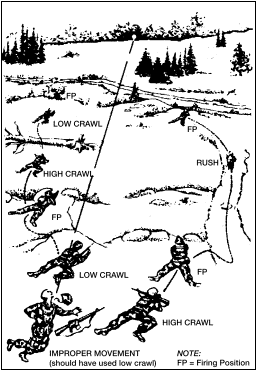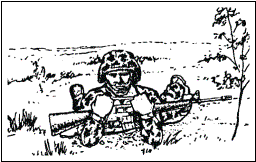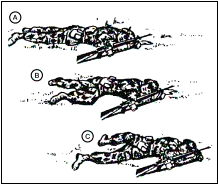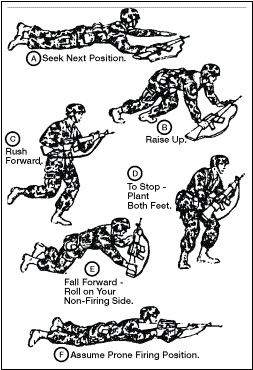|
Performance
Steps
|
|
1. Select an
individual movement route within your
team or squad route or axis of advance
(figure 071-326-0502-1).
|
|

Figure 071-326-0502-1.
Individual movement route
|
a.
Search the terrain to
your front for-
|
(1)
A gully, ravine, ditch,
or wall at a slight angle to your
direction of movement.
|
|
Note. These features provide cover and concealment when using
the low or high crawl.
|
(2)
Hedgerows or a line of
thick vegetation.
|
|
Note. These features provide only concealment when using the
low or high crawl.
|
(3)
Large trees, rocks,
stumps, fallen timber, rubble,
vehicle hulks, folds or creases in
the ground.
|
|
Note. These features provide cover and concealment for use as
temporary positions. Use the rush if
the area between them has no
concealment.
|
(4)
High grass or weeds.
|
|
Note. These features provide only partial concealment. You can
use the rush since the use of the high
or low crawl could reveal your
location by the movement of
vegetation.
|
b.
Select your next position
(and the route to it) as one that-
|
(1)
Exposes you to the
least enemy fire.
|
(2)
Does not require you to
cross in front of other members of
your element, masking their fires.
|
|
2. Determine the correct individual movement
technique.
|
a.
Select the high crawl
when-
|
(1)
Route provides cover
and concealment.
|
(2)
Poor visibility reduces
enemy observation.
|
(3)
Speed is required but
the terrain and vegetation are
suitable only for the low crawl.
|
b.
Select the low crawl
when-
|
(1)
The route provides
cover or concealment less than one
foot high.
|
(2)
Visibility provides the
enemy good observation.
|
(3)
Speed is not required.
|
c.
Select the rush when-
|
(1)
You must cross open
areas.
|
(2)
Time is critical.
|
|
3. Communicate the movement plan to your buddy or team
leader using hand signals so the
soldier not moving can cover by fire
any movement by the other soldier.
|
|
Note. When moving as a member of a fire team, watch and listen
to your team leader who will lead you
along the best route and ensure that
covering fire is provided when you
move. Stay with your team leader and
follow his example.
|
|
4. Use the high crawl (figure 071-326-0502-2).
|
|

Figure 071-326-0502-2.
High crawl
|
a.
Keep your body off the
ground
|
b.
Rest your weight on your
forearms and lower legs.
|
c.
Cradle your weapon in
your arms, keeping its muzzle off
the ground.
|
d.
Keep your knees well
behind your buttocks so it stays
low.
|
e.
Move forward by
alternately advancing your right
elbow and left knee, and left elbow
and right knee.
|
|
5. Use the low crawl (figure 071-326-0502-3).
|
a.
Keep your body as flat
as possible to the ground.
|
b.
Hold your weapon by
grasping the sling at the upper
sling swivel, letting the
handguard rest on your forearm and
the butt of the weapon drag on the
ground, thus keeping the muzzle
off the ground.
|
c.
Move forward by-
|
(1)
Pushing both arms
forward while pulling your right
leg forward.
|
(2)
Pulling with both
arms while pushing with your
right leg.
|
(3)
Continuing this
push-pull movement until you
reach your next position,
changing your pushing leg
frequently to avoid fatigue.
|
|

Figure 071-326-0502-3.
Low crawl
|
|
6. Use the rush
to move from one covered position to
another when enemy fire allows brief
exposure (figure 071-326-0502-4).
|
a.
Move from your firing
position by rolling or crawling.
|
b.
Start from the prone
position.
|
c.
Select your next
position by slowly raising your
head.
|
d.
Lower your head while
drawing your arms into your body,
keeping your elbows down, and
pulling your right leg forward.
|
e.
Raise your body in one
movement by straightening your
arms.
|
f.
Spring to your feet,
stepping off with either foot.
|
g.
Run to the next
position–
|
(1)
Keeping the distance
short to avoid accurate enemy
fire.
|
(2)
Trying not to stay up
any longer than 3 to 5 seconds
so that the enemy does not have
time to track you with automatic
fire.
|
|

Figure 071-326-0502-4.
Rush
|
h.
Plant both feet just
before hitting the ground.
|
i.
Fall forward by:
|
(1)
Sliding your right
hand down to the heel of the
butt of your weapon.
|
(2)
Breaking your fall
with the butt of your weapon.
|
j.
Assume a firing
position.
|
(1)
Roll on your side.
|
(2)
Place the butt of
your weapon in the hollow of
your shoulder.
|
(3)
Roll or crawl to a
covered or concealed firing
position.
|
|
7. Cover your buddy’s movement with fire.
|
|
Performance
Measures
|
GO
|
NO
GO
|
|
1. Selected an individual movement route within the
team or squad route or axis of advance
that provided cover or concealment
such as:
|
—
|
—
|
a.
A gully, ravine, ditch,
or wall at a slight angle to the
direction of movement.
|
|
|
b.
Hedgerows
or a line of thick vegetation.
|
|
|
c.
Large
trees, rocks, stumps, fallen timber,
rubble, vehicle hulks, folds or
creases in the ground.
|
|
|
d.
High
grass or weeds.
|
|
|
|
2. Selected the next position (and the route to it) as
one that-
|
—
|
—
|
a.
Exposed you to the least
enemy fire.
|
|
|
b.
Did
not require you to cross in front of
other members of your element,
masking their fires.
|
|
|
|
3. Determined the correct movement technique.
|
—
|
—
|
a.
Selected the high crawl
when–
|
|
|
(1)
The route provided
cover and concealment.
|
|
|
(2)
Poor visibility reduced
enemy observation.
|
|
|
(3)
Speed was required but
the terrain and vegetation was
suitable only for the low crawl.
|
|
|
b.
Selected
the low crawl when-
|
|
|
(1)
The route provided
cover or concealment less than 1
foot high.
|
|
|
(2)
Visibility provided the
enemy good observation.
|
|
|
(3)
Speed was not required.
|
|
|
c.
Selected
the rush when-
|
|
|
(1)
Crossing open areas.
|
|
|
(2)
Time was critical.
|
|
|
|
4. Communicated movement plan using hand signals so
that the soldier not moving could
cover by fire any movement by the
other soldier.
|
—
|
—
|
|
5. Used the high crawl.
|
—
|
—
|
a.
Kept body off the ground.
|
|
|
b.
Rested
weight on forearms and lower legs.
|
|
|
c.
Cradled
weapon in, keeping its muzzle off
the ground.
|
|
|
d.
Kept
knees well behind buttocks.
|
|
|
e.
Moved
forward by alternately advancing
right elbow and left knee, and left
elbow and right knee.
|
|
|
|
6. Used the low crawl.
|
—
|
—
|
a.
Kept body as flat as
possible to the ground.
|
|
|
b.
Held
weapon by grasping the sling at the
upper sling swivel, letting the
handguard rest on forearm and the
butt of the weapon drag on the
ground, thus keeping the muzzle off
the ground.
|
|
|
c.
Moved
forward by-
|
|
|
(1)
Pushed both arms
forward while pulling right leg
forward.
|
|
|
(2)
Pulled with both arms
while pushing with right leg.
|
|
|
(3)
Continued push-pull
movement until reaching next
position; changed pushing leg
frequently to avoid fatigue.
|
|
|
|
7. Used the rush to move from one covered position to
another.
|
—
|
—
|
a.
Moved from firing
position by rolling or crawling.
|
|
|
b.
Started
from the prone position.
|
|
|
c.
Selected
next position by slowly raising
head.
|
|
|
d.
Lowered
head while drawing arms in, keeping
elbows down, and pulling right leg
forward.
|
|
|
e.
Raised
body in one movement by
straightening arms.
|
|
|
f.
Sprang to feet, stepping
off with either foot.
|
|
|
g.
Ran
to the next position–
|
|
|
(1)
Kept the distance
short.
|
|
|
(2)
Did not stay up any
longer than 3 to 5 seconds.
|
|
|
h.
Planted
both feet just before hitting the
ground.
|
|
|
i.
Fell forward by-
|
|
|
(1)
Sliding right hand down
to the heel of the butt of weapon.
|
|
|
(2)
Breaking fall with the
butt of the weapon.
|
|
|
j.
Assumed a firing
position.
|
|
|
(1)
Rolled on side.
|
|
|
(2)
Placed the butt of the
weapon in the hollow of shoulder.
|
|
|
(3)
Rolled or crawled to a
covered or concealed firing
position.
|
|
|
|
8. Covered buddy’s movement with fire.
|
—
|
—
|